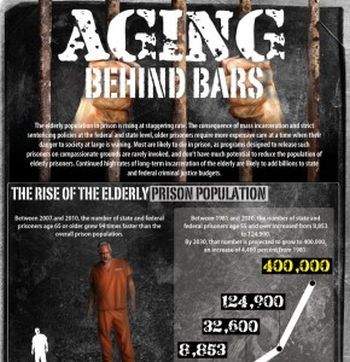
Publisher:
Bonnie King
CONTACT:
Newsroom@Salem-news.com
Advertising:
Adsales@Salem-news.com

~Truth~
~Justice~
~Peace~
TJP
Jun-12-2013 15:17

 TweetFollow @OregonNews
TweetFollow @OregonNews
Aging Behind Bars (Infographic)
Salem-News.comBetween 1981 and 2010, the number of state and federal prisoners age 55 and over increased from 8,853 to 124,900.
 Learn more, visit: criminaljusticedegreehub.com |
(WASHINGTON DC) - The elderly population in prison is rising at staggering rate. The consequence of mass incarceration and strict sentencing policies at the federal and state level, older prisoners require more expensive care at a time when their danger to society at large is waning. Most are likely to die in prison, as programs designed to release such prisoners on compassionate grounds are rarely invoked, and don’t have much potential to reduce the population of elderly prisoners. Continued high rates of long-term incarceration of the elderly are likely to add billions to state and federal criminal justice budgets.
The Rise of the Elderly Prison Population
Between 2007 and 2010, the number of state and federal prisoners age 65 or older grew 94 times faster than the overall prison population.
Between 1981 and 2010, the number of state and federal prisoners age 55 and over increased from 8,853 to 124,900. By 2030, that number is projected to grow to 400,000, an increase of 4,400 percent from 1981.
4 Types of Elderly Prisoners
Old offenders
Age at 1st incarceration: 50 or older
Sentence length: 20 years or more
# of terms: 1st prison term
Crimes committed: Murder or sex crimes
Young long-term prisoners
Age at 1st incarceration: Younger than 50
Sentence length: Varies
# of terms: Either 1st term or repeat offenders
Crimes committed: Murder, armed robbery, rape, repeat drug offenses
Repeat prisoners
Age at 1st incarceration: Younger than 50
Sentence length: 20 years or more
# of terms: 2nd or more
Crimes committed: Burglary, theft, drug possession
Young short-term offenders
Age at 1st incarceration: Younger than 50
Sentence length: Less than 20 years
# of terms: 1st
Crime committed: Burglary, theft, drug possession
Why The Elderly Are In Prison
The overall prison population has doubled during the past 20 years from 739980 prisoners in 1990 to 1543206 prisoners in 2010 due to truth-in-sentencing guidelines and “three strikes” laws.
The number of inmates serving life sentences quadrupled between 1984 and 2008; inmates who live a long time with life sentences will grow old and are most likely to die in prison.
The number of inmates sentenced to life without parole more than tripled between 1992 and 2008.
Government Fiscal Impact
Care for aging prisoners is at least twice as expensive than for younger prisoners because this population:
* Has more health problems and requires more medical care
* Requires longer and more frequent hospitalizations
* Needs care outside of the prison system, which represents 72 percent of all healthcare costs spent on aging prisoners Managing the Problem
By the time a person turns 50, the likelihood of that person committing another crime has dropped precipitously. Only 16.9 percent of prisoners released at age 45 and older return for new sentences.
Policies that could reduce the number of aging prisoners include:
* Granting conditional release for aging prisoners who pose little safety risk
* Utilizing and expanding medical parole
* Reauthorizing and expanding aging prisoner release programs
States could save an average of $66,294 every year for each released aging prisoner, which accounts for increased parole, housing and public benefits costs.
Impact of annual cost savings of releasing the average aging prisoner versus keeping them behind bars:
* Low, $28,362
* Medium, $66,294
* High, $104,434.
SOURCES
Bureau of Justice Statistics, Human Rights Watch, American Civil Liberties Union, Pew Center for the States
 Source - http://www. |
Learn more - http://www.
 |
 |
 |
Articles for June 11, 2013 | Articles for June 12, 2013 | Articles for June 13, 2013
Quick Links
DINING
Willamette UniversityGoudy Commons Cafe
Dine on the Queen
Willamette Queen Sternwheeler
MUST SEE SALEM
Oregon Capitol ToursCapitol History Gateway
Willamette River Ride
Willamette Queen Sternwheeler
Historic Home Tours:
Deepwood Museum
The Bush House
Gaiety Hollow Garden
AUCTIONS - APPRAISALS
Auction Masters & AppraisalsCONSTRUCTION SERVICES
Roofing and ContractingSheridan, Ore.
ONLINE SHOPPING
Special Occasion DressesAdvertise with Salem-News
Contact:AdSales@Salem-News.com

googlec507860f6901db00.html



Terms of Service | Privacy Policy
All comments and messages are approved by people and self promotional links or unacceptable comments are denied.
Anonymous June 13, 2013 7:11 am (Pacific time)
Never accept hatred along these lines, people who bash gays almost always are battling with their own homosexual tendencies. I used to be a gay basher, now I am an openly gay man, it is a great thing to be honest, and I smash the heads of gay bashers, bring 'em on!
[Return to Top]©2025 Salem-News.com. All opinions expressed in this article are those of the author and do not necessarily reflect those of Salem-News.com.